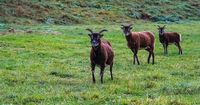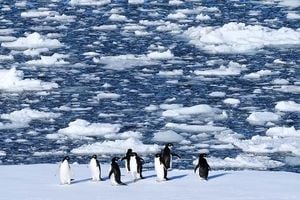On the windswept, remote archipelago of St Kilda, more than 40 miles west of Scotland’s Western Isles, a centuries-old drama unfolds every winter. The island’s famous Soay sheep, a rare and ancient breed, roam wild over the rugged landscape of Hirta—the main island of St Kilda. But as the cold months descend, hundreds of these sheep starve to death, victims of a harsh environment and what some argue is a lack of human intervention.
This September, the debate over the fate of the Soay sheep reached a new intensity. Two local vets, David Buckland and Graham Charlesworth, renewed their call for greater protection and population control of the breed. Their plea, reported by BBC, The Herald, and The Telegraph, is rooted in years of observation and data: every winter, as grass becomes scarce, the island’s sheep population faces a brutal struggle for survival. According to the University of Edinburgh’s St Kilda Soay Sheep Project, which has tracked the flock since 1985, the number of sheep on Hirta now exceeds 1,800. Yet, in some years, more than 1,000 sheep—including lambs—have died, with average yearly mortality rarely dropping below 400.
Buckland and Charlesworth argue that these deaths are not merely numbers in a ledger but a pressing animal welfare issue. “In some ways for a vet it’s not the numbers dying, it’s the manner of dying. Starvation is not a good death and it’s the suffering that concerns us,” Buckland told BBC Alba’s Eòrpa programme. Their solution? Remove a small number of sheep from Hirta each year to reduce the population, thereby ensuring adequate grazing for those that remain. “We are not looking for intensive farming; we are just looking at measures to reduce the suffering and reduce the numbers dying from starvation,” Buckland explained.
Soay sheep are no ordinary breed. Named after the small, uninhabited island of Soay in the St Kilda group, they are believed to be descended from sheep first brought to the islands in prehistoric times. Their fleeces display an unusual variety of colors, including dark brown, and their small, hardy frames are well-suited to the challenging environment. For thousands of years, these sheep have survived with little to no human management, especially after the last permanent human residents left St Kilda in 1930, taking most of their livestock with them. In the years that followed, about 100 sheep were moved from Soay to Hirta, where they have since thrived—and multiplied.
Yet, the very wildness that makes the Soay sheep remarkable is at the heart of the current controversy. The Scottish Government and the National Trust for Scotland (NTS), which owns St Kilda, both classify the sheep as wild animals. As such, they are protected under the Wild Mammals (Protection) Act 1996—the same law that covers Scotland’s wild deer—but they are not subject to the welfare laws that govern farm animals. “The Soay sheep on St Kilda are considered wild animals due to their unique history of adapting to life without management for many generations,” a Scottish Government spokesperson told BBC Scotland.
Buckland and Charlesworth, however, challenge this classification. They argue that the sheep, having undergone thousands of years of domestication, should not be regarded as truly wild. “Pain and suffering is natural but cruelty is a human concept and really that is sort of what you are seeing happening out there,” Charlesworth, now retired, told the BBC. Their position is clear: the sheep’s suffering, caused by starvation, is a human responsibility, and measures should be taken to reduce it.
The National Trust for Scotland, for its part, acknowledges the complexity of the issue. Diarmaid Hearns of NTS told the BBC that St Kilda’s remote location would make active management of the sheep challenging. “It would be a real change in thinking from government for them to be reclassified. We are always interested in what other people’s views are and if times change then we will change with them,” he said. The NTS also points out that, over the past forty years, the overall population of sheep has remained stable, and their policy is one of non-intervention except in exceptional circumstances. “Alongside the seabirds of St Kilda, the sheep are treated as wild animals with a presumption against intervention, except in exceptional circumstances,” a spokesman told The Telegraph.
But the question remains: does non-intervention serve the sheep, or simply preserve a status quo that leads to unnecessary suffering? Professor Josephine Pemberton, who managed the St Kilda Soay Sheep Project for many years, offers a scientific—and cautionary—perspective. She warns that human intervention might have unintended consequences. “Winter mortality of lambs removes inbred individuals, removes bad genes, so the flock has this purging thing the whole time which I don’t think we would be able to organise,” she told the BBC. In other words, the harsh natural selection that takes place each winter might actually strengthen the flock’s resilience to disease and parasites. Intervening, she suggests, could make the population more vulnerable in the long run.
The debate over the Soay sheep is complicated further by the unique status of St Kilda itself. The archipelago is a UNESCO World Heritage site, recognized for both its natural and cultural importance. Hirta, the largest island, has no permanent human residents today, but is temporarily inhabited by NTS workers, scientists, and contractors working at a small Ministry of Defence site. The sheep, along with seabirds and other wildlife, are part of what makes St Kilda such a special—and scientifically valuable—place.
For Buckland and Charlesworth, the issue is not about erasing the wildness of St Kilda, but about finding a balance between nature and compassion. They are not calling for the sheep to be farmed intensively, but for simple measures that could reduce suffering and prevent mass starvation. Their analysis of the St Kilda Soay Sheep Project’s data suggests that the current approach leads to unacceptable levels of animal suffering, a view echoed by others who have witnessed the winter die-offs firsthand.
Still, the counterarguments are powerful. The Scottish Government and NTS maintain that the sheep’s adaptation to life without human management is what makes them—and St Kilda—so unique. Intervening, they argue, could disrupt a delicate ecological and evolutionary balance that has persisted for millennia. For now, the sheep remain classified as wild, protected under law but left to the mercy of the island’s unforgiving winters.
As the debate continues, one thing is certain: the fate of the Soay sheep on St Kilda is more than just a question of animal numbers. It is a test of where society draws the line between respecting nature’s course and stepping in to alleviate suffering. With both sides making passionate, well-reasoned arguments, the future of these remarkable animals—and the policies that govern them—remains uncertain. But the world, it seems, is watching.




